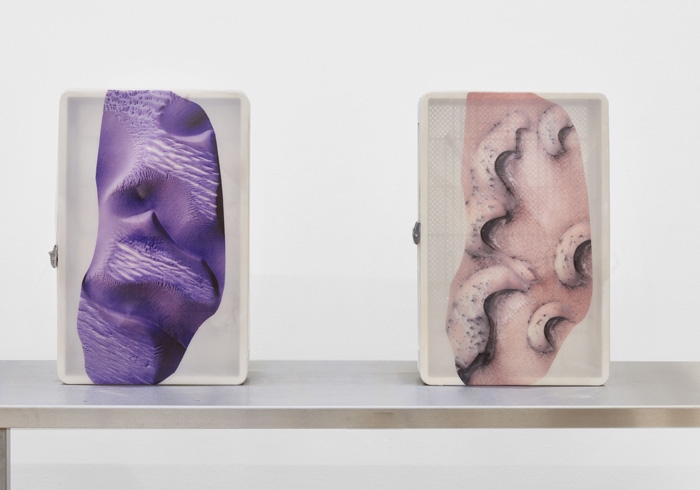Kunsthalle Basel, 19 May – 13 August 2017
The German word ungestalt translates as amorphous or unshapely, with a goodly negative connotation. Pull the word apart and there’s more potential inside: the ‘un-’ suggests something undone or opposing; ‘gestalt’ is not just form or shape but figure or likeness too. The wonderful sleight of this exhibition is to apply these ideas literally and formally, in the process creating a show more of its time than many a recent socially or politically themed project.
Works by 16 artists – from Marcel Duchamp to the youngest participant, American artist Eric N. Mack (b. 1987) – tease out the potential of rejecting clear shape, of deforming materials or things and of refusing to fulfil the artist’s traditional form-giving role. Prominent positions are given to Joachim Bandau’s sculptures from the 1960s and 70s, with their functional and powerful vocabulary using lacquered fibreglass, metal and rubber; his large Fahrbare schwarze Sesselgruppe (Driveable Black Group of Chairs, 1971) sets up two shiny black armchairlike (though seatless) sculptural elements in a faceoff, the pair conjoined by ridged hosing extruded from metal fittings, while metal grips and castors indicate portability. Industrial materials are made redundant, looking utilitarian but good for nothing. Other pieces spill over the lines of a form, like Caroline Achaintre’s hand-tufted wool work MadCap (2017), which hangs high up one wall, its muddled face seen through a tangle of loose-hanging yarn, as if claiming expressive painting’s gestures for a customarily tidy medium. The aforementioned Mack, too, resists traditional formats and categorisations, his collages of pop, fashion and broadsheet publications on found fabric backings dangling onto the floor or, in Parade (2016), outlining a dog-eared approximation of a US map, from the centre of which Prince eyes the viewer. The high-end production of Lucie Stahl’s aluminium-mounted scanner-photographed prints is countered by oozing or gravid subjects: Restrictions (Made in USA) (2016), for example, being an object wrapped in patriotic material that strains against the string binding it.
Installations that looked reasonably tidy for the press photographer decomposed as the exhibition proceeded, undoing themselves; Adrián Villar Rojas’s Untitled (2017, from the series Rinascimento) is a fridge into which a still life of lobster, champagne and much else is stuffed, rotting and stinking a little more each time a viewer opened the door. Olga Balema’s become a stranger to yourself (2017) is a collage in liquid that writes its own oblivion, because it shrinks each time it is exhibited, when the PVC pillow is filled with water, sealed, then cut open at the end of the show. Tomo Savić-Gecan’s Untitled (2005–17) also diminishes, the work a notional value of itself registered on the Kunsthalle website that continually decreases till it vanishes entirely by exhibition’s close. Still other pieces map the shape of ideas heading off on countless tangents, especially Nathalie Perrin’s diagrams of associations in cramped pencil on paper; play with expectations of texture; or work with negative impressions. Shape and form are sometimes pending: Park McArthur’s two versions of Polyurethane Foam (2014) are two blocks of foam, their wrapping still attached, waiting to be made into the thing they might be.
The duo Pakui Hardware’s eerie installation Hesitant Hand (2017) is the show’s killer blow: in a sterile installation, plastic trays used for conveyor-belt processes covered in delicately vibrating printed gauze have been placed on a low steel shelving unit as a robot had positioned them in a previous installation of the work. This work is aesthetically cool and chimes with contemporary concerns about who and what we cede authority to. Can we always tell who or what is forming an environment? For artistic experiments with authorship, agency, noncompliance and outsourced decision-making are not merely creative exercises in the isolated sphere of the aesthetic, but raise questions that can be applied elsewhere. Does modern life allow the unformed, or will that vacuum be filled?
From the October 2017 issue of ArtReview
